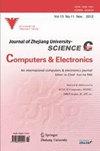Quantitative evaluation of model consistency evolution in compositional service-oriented simulation using a connected hyper-digraph
Journal of Zhejiang University-Science C-Computers & Electronics
Pub Date : 2014-01-01
DOI:10.1631/jzus.C1300089
引用次数: 1
Abstract
Appropriate maintenance technologies that facilitate model consistency in distributed simulation systems are relevant but generally unavailable. To resolve this problem, we analyze the main factors that cause model inconsistency. The analysis methods used for traditional distributed simulations are mostly empirical and qualitative, and disregard the dynamic characteristics of factor evolution in model operational running. Furthermore, distributed simulation applications (DSAs) are rapidly evolving in terms of large-scale, distributed, service-oriented, compositional, and dynamic features. Such developments present difficulty in the use of traditional analysis methods in DSAs, for the analysis of factorial effects on simulation models. To solve these problems, we construct a dynamic evolution mechanism of model consistency, called the connected model hyper-digraph (CMH). CMH is developed using formal methods that accurately specify the evolutional processes and activities of models (i.e., self-evolution, interoperability, compositionality, and authenticity). We also develop an algorithm of model consistency evolution (AMCE) based on CMH to quantitatively and dynamically evaluate influencing factors. Experimental results demonstrate that non-combination (33.7% on average) is the most influential factor, non-single-directed understanding (26.6%) is the second most influential, and non-double-directed understanding (5.0%) is the least influential. Unlike previous analysis methods, AMCE provides good feasibility and effectiveness. This research can serve as guidance for designers of consistency maintenance technologies toward achieving a high level of consistency in future DSAs.基于连通超有向图的组合服务仿真模型一致性演化定量评价
促进分布式仿真系统中模型一致性的适当维护技术是相关的,但通常不可用。为了解决这个问题,我们分析了导致模型不一致的主要因素。传统的分布式仿真分析方法多为经验和定性分析,忽略了模型运行过程中因素演化的动态特性。此外,分布式仿真应用程序(dsa)在大规模、分布式、面向服务、组合和动态特性方面正在迅速发展。这样的发展使得在dsa中使用传统分析方法来分析模拟模型的析因效应变得困难。为了解决这些问题,我们构建了一种模型一致性的动态演化机制,称为连通模型超有向图(CMH)。CMH是使用正式的方法开发的,这些方法精确地指定了模型的进化过程和活动(即,自进化、互操作性、组合性和真实性)。提出了一种基于CMH的模型一致性演化(AMCE)算法,对影响因素进行定量、动态评价。实验结果表明,非组合(33.7%)是影响最大的因素,非单向理解(26.6%)的影响次之,非双向理解(5.0%)的影响最小。与以往的分析方法不同,AMCE具有较好的可行性和有效性。本研究可为一致性维护技术的设计者提供指导,以在未来的dsa中实现高水平的一致性。
本文章由计算机程序翻译,如有差异,请以英文原文为准。
求助全文
约1分钟内获得全文
求助全文
来源期刊
自引率
0.00%
发文量
0
审稿时长
2.66667 months

 求助内容:
求助内容: 应助结果提醒方式:
应助结果提醒方式:


